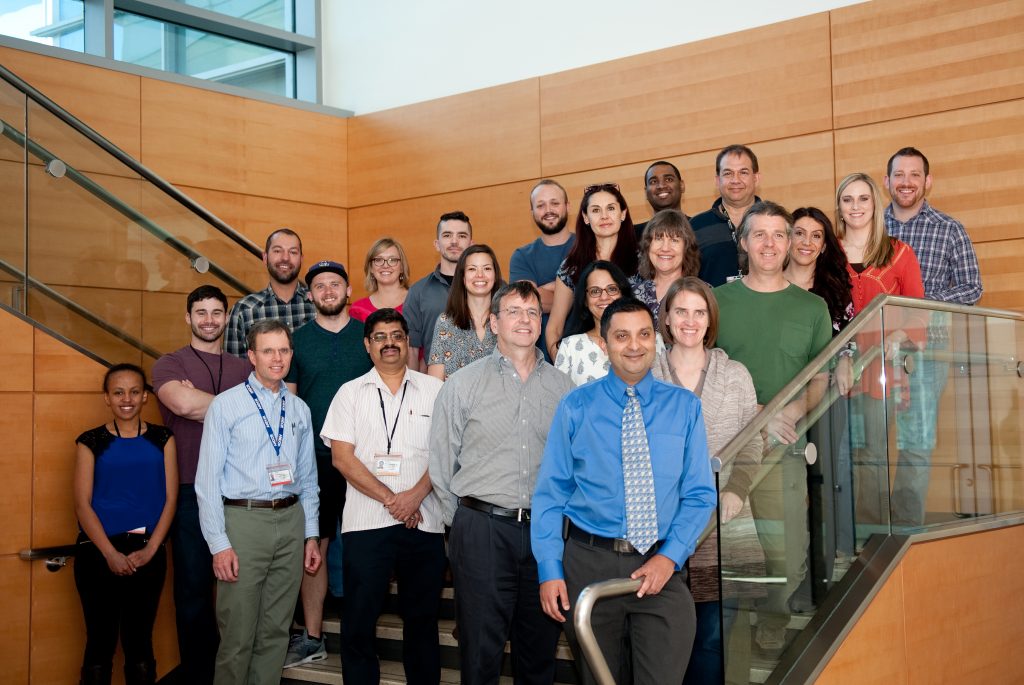
Doctors and Researchers of The Morgan Adams Foundation Pediatric Brain Tumor Research Program
The Morgan Adams Foundation Board of Directors has granted
$625,000 to fund 11 research projects and equipment in The Morgan Adams Pediatric Brain Tumor Research Program at Children’s Hospital Colorado in 2018. This brings the total amount of research dollars we’ve funded since our inception in 2001 to more than $4.7 million dollars.
“The crucial support from Morgan Adams continues to fund all those high-risk, high-reward studies that would otherwise not be possible,” said Rajeev Vibhakar, MD, PhD and Program Leader of Pediatric Neuro-Oncology at the University of Colorado School
of Medicine and Children’s Hospital Colorado. “It is these studies that often lead to novel, groundbreaking research projects and subsequent therapeutic
interventions.” (Below is a summary of the research projects funded in 2018. We’ll tell you more about these projects and the equipment in upcoming
newsletters.)
of Medicine and Children’s Hospital Colorado. “It is these studies that often lead to novel, groundbreaking research projects and subsequent therapeutic
interventions.” (Below is a summary of the research projects funded in 2018. We’ll tell you more about these projects and the equipment in upcoming
newsletters.)
2018 PROJECTS FUNDED
The RNASeq transition: Creation of a pediatric brain tumor RNAseq reference database (year 2 of 2)
Andrew Donson, Nick Foreman, Rajeev Vibhakar
Through 15 years of using gene chip technology (“chipping”) to analyze tissues of brain tumor samples, The Morgan Adams lab now houses one of the largest
pediatric brain tumor gene expression databases in existence. This resource has been an essential reference set for state-of-the-art diagnosis, allowing
researchers to assign children’s brain tumors into newly described and clinically relevant pediatric brain tumor subgroups. RNA sequencing provides
amplified data, giving researchers the unprecedented opportunity to identify the DNA mutations underlying tumor growth. Identification of tumor mutations
will allow more definitive identification of tumor types so that more effective chemotherapy can be selected to specifically target these tumors.
pediatric brain tumor gene expression databases in existence. This resource has been an essential reference set for state-of-the-art diagnosis, allowing
researchers to assign children’s brain tumors into newly described and clinically relevant pediatric brain tumor subgroups. RNA sequencing provides
amplified data, giving researchers the unprecedented opportunity to identify the DNA mutations underlying tumor growth. Identification of tumor mutations
will allow more definitive identification of tumor types so that more effective chemotherapy can be selected to specifically target these tumors.
Chipping “in the round.” Extension of tumor characterization to include mutational and fusion data on all new patients
Nick Foreman, Andrew Donson, Rajeev Vibhakar
Researchers will use RNA sequencing to analyze new tumors, as well as tumor samples from the last 30 years. This project will extend the analysis to identifying
whether tumors result from gene mutations or fusions of existing genes. This improved characterization of tumor samples provides additional information
to help determine the best treatment for each tumor.
whether tumors result from gene mutations or fusions of existing genes. This improved characterization of tumor samples provides additional information
to help determine the best treatment for each tumor.
High throughput next-gen sequencing and analysis of CRISPR-Cas9 mediated gene knockout system
Sujatha Venkataraman, Rajeev Vibhakar
This project will perform sequencing and analysis of different brain tumor cells based on CRISPR/Cas9 platforms from two companies. CRISPR/Cas9 is a technology
that enables researchers to edit parts of the genome by removing, adding, or altering sections of the DNA sequence. (Paid for by The Adam Crocker Fund
for Cancer Research.)
that enables researchers to edit parts of the genome by removing, adding, or altering sections of the DNA sequence. (Paid for by The Adam Crocker Fund
for Cancer Research.)
Lab model to investigate nanoparticle-mediated brain drug delivery (year 3 of 3)
Krishna Madhavan, Rajeev Vibhakar
Many of the drugs used in chemotherapy to treat brain tumors perform very well in the laboratory settings, but they fail to cross the blood-to-brain barrier
in direct clinical applications, meaning the chemotherapy doesn’t reach the tumor. This project will study the delivery of drugs using gold nanoparticles
into brain tumor cells in lab models to evaluate the effectiveness of delivery routes and the drug dosage required to be effective.
in direct clinical applications, meaning the chemotherapy doesn’t reach the tumor. This project will study the delivery of drugs using gold nanoparticles
into brain tumor cells in lab models to evaluate the effectiveness of delivery routes and the drug dosage required to be effective.
Pre-clinical modeling of drug efficacy in pediatric brain tumors
Angela Pierce, Rajeev Vibhakar
Development of novel drugs to treat pediatric brain tumors is often complicated by a lack of robust pre-clinical data and lab modeling of drugs. This frequently
results in phase 1 clinical trials that fail. To avoid situations like this, we have established pre-clinical models of a range of brain tumors (funded
by MAF in 2015) and we can test multiple drugs using this platform. These studies will leverage data from all MAF-funded research from the past 7 years
to test novel therapeutics and combinations.
results in phase 1 clinical trials that fail. To avoid situations like this, we have established pre-clinical models of a range of brain tumors (funded
by MAF in 2015) and we can test multiple drugs using this platform. These studies will leverage data from all MAF-funded research from the past 7 years
to test novel therapeutics and combinations.
High-throughput drug screening in pediatric brain tumors for rapid clinical translation
Andrew Donson, Nick Foreman, Katie Dorris
This project will systematically test more than 100 FDA-approved oncology drugs on all pediatric tumor types, using an established process that allows
testing to be done quickly, using tumor samples obtained from Children’s Hospital Colorado patients. Previous analysis by researchers led to the identification
of novel therapeutic approaches for a patient with an Ependymal tumor.
testing to be done quickly, using tumor samples obtained from Children’s Hospital Colorado patients. Previous analysis by researchers led to the identification
of novel therapeutic approaches for a patient with an Ependymal tumor.
By specifically testing FDA-approved compounds that already have known treatment effects in adults and often children, the results of testing can be rapidly
applied to patients without the need for time-consuming drug development and safety testing.
applied to patients without the need for time-consuming drug development and safety testing.
Disease progression model for H3K27M-mutant DIPG: Determining downstream effects of effective treatment
Sujatha Venkataraman, Adam Green
Diffuse intrinsic pontine gliomas (DIPG) are aggressive tumors at the base of the brain that typically are untreatable. In the past several years, major
sequencing projects have found most of these tumors harbor a mutation in histone 3 called H3K27M, which is unique in human disease. Histones are proteins
around which DNA folds and mutations in these proteins have major implications for which genes are turned on and off. We believe that a better understanding
of the H3K27M mutation’s effects will allow us to target DIPG treatments against the combination of genetic changes truly driving the tumor.
sequencing projects have found most of these tumors harbor a mutation in histone 3 called H3K27M, which is unique in human disease. Histones are proteins
around which DNA folds and mutations in these proteins have major implications for which genes are turned on and off. We believe that a better understanding
of the H3K27M mutation’s effects will allow us to target DIPG treatments against the combination of genetic changes truly driving the tumor.
The oncogenic role of the SEC in H3K27M-mutant DIPG
Nathan Dahl, Rajeev Vibhakar
This project seeks to understand secondary factors, in addition to mutations in the histone 3 gene (H3K27M), that lead to growth of the DIPG tumor.
Completion of this project will bring new understanding of the mechanisms by which H3K27M mutations drive the formation of DIPGs and lay the groundwork
for a novel therapeutic approach in treating these tumors.
Completion of this project will bring new understanding of the mechanisms by which H3K27M mutations drive the formation of DIPGs and lay the groundwork
for a novel therapeutic approach in treating these tumors.
Use of pluripotent stem cells (hiPSCs) to model DIPG cell formation and radio-resistance
Sujatha Venkataraman, Rajeev Vibhakar
This project will use stem cells to create lab models of DIPG tumors and better understand the biology of this tumor, including how tumor cells
form and how they develop resistance after radiation. Understanding the biology of a tumor is the best way to target the tumor effectively.
This will ultimately result in new therapies for DIPG patients.
form and how they develop resistance after radiation. Understanding the biology of a tumor is the best way to target the tumor effectively.
This will ultimately result in new therapies for DIPG patients.
Analysis of paired BRAF V600E mutant glioma patient samples to identify novel resistance mechanisms to targeted BRAF inhibition
Jean Mulcahy-Levy, Theodore Nicolaides
(University of California San Francisco)
BRAF V600E mutations occur in a variety of gliomas, and the development of targeted therapies has provided a new treatment option for some patients.
However, research shows that these mutations are likely to develop a resistance to these therapies. This project seeks to identify molecular
and pathway alterations driving resistance to BRAF V600E inhibitors in central nervous system tumors. This will provide tools to identify patients
who will need additional therapies to treat their tumors.
However, research shows that these mutations are likely to develop a resistance to these therapies. This project seeks to identify molecular
and pathway alterations driving resistance to BRAF V600E inhibitors in central nervous system tumors. This will provide tools to identify patients
who will need additional therapies to treat their tumors.
Oncogenesis caused by loss of SMARCB1 tumor suppressor is dependent on the activity of SIRT2
Rajeev Vibhakar
This project seeks to determine the molecular mechanisms by which the SIRT2 gene drives atypical teratoid/rhabdoid (AT/RT) tumor progression
and to provide pre-clinical validation that using the drug TM is a worthwhile therapeutic approach. It is expected that this will then
progress to a phase 1 clinical trial for treating AT/RT patients.
and to provide pre-clinical validation that using the drug TM is a worthwhile therapeutic approach. It is expected that this will then
progress to a phase 1 clinical trial for treating AT/RT patients.

